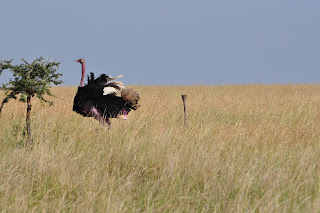Over the next two days in the Serengeti, we would see a plethora of birds, including Secretary birds, Hammerkop, Red-billed Francolins, Helmeted Guineafowl, Fischer's lovebirds, Crested cranes, Superb Starlings, Lilac-breasted rollers and a multitude of sunbirds, hornbills, shrikes and vultures. More importantly, we also encountered cheetahs, lions and leopards, animals I had not seen on my previous safaris.
Lilac-breasted roller
Superb starlings
Sunbirds
The zebras and wildebeest started on their migration to the Kenyan Maasai Mara, at times in long single files, usually the zebras taking the lead. On their way they grazed, usually in the morning or in the evening, waded into the streams or enjoyed the shade of an acacia.
We watched the zebras and Wildebeest entering a waterhole. The zebras usually led the way, as the Wildebeest were more fearful of drowning or being attacked. The zebras piled in, waist-deep in the water, huddled in long chains side-by-side, until there was a random noise or splash in the water, a growl of an imaginary lion or the plunge of a crocodile, and all of the zebra, along with the rare Wildebeest evacuated the waters in a chaotic pandemonium. Once they made it safely to shore, they stopped, reflected, reassessed the imagined threat, then one by one they entered the pond, retunring to the same formation. They enjoyed the water for a few seconds, before another unfamiliar noise disrupted their pleasure.
Zebras and wildebeest hanging out under a shady
acacia
In "again"
Out "again"
There were numerous animals with offspring, elephants, wildcats, zebras and giraffes. We followed two baby hippos running through the brush to escape our cameras (or were they just late for school?).
There were a few hippos, but they lay mainly submerged in the streams. They were most active in the nighttime. Lions and tigers were also generally lazing around all day, usually resting 20 hours a day. They were active only while hunting, which occurred mainly early at daybreak or at sunset.
We were able to watch these larger cats hunt on several occasions. Usually, the animals could be spotted by an observant guide like Hussein, or by other cars stopping along the road. We encountered only a handful of jeeps the whole morning. We encountered a cheetah with three cubs that playfully wandered to a waterhole past a tribe of Thompson gazelle. The cubs playfully pranced toward the petrified gazelles, some retreating, others stiffened in opposition, facing the threat like statues of indignation.
We watched three lions creeping up on a herd of water buffalo, surely looking for a calf that would wander off from its mother. There they lay, crouching in the tall grass, for an hour, waiting, crawling a few inches, then crouching and watching. The herd had not noticed them until a clan of Thompson gazelle approached them. They were alerted by their smell which was carried by a breeze over the tops of the waving grass.
In another area, we encountered hyenas and vultures, a sure sign of a successful hunt. Nearby we would expect to find a pack of lions that were obviously satiated.
And some mating ostriches. The male announces his interest by hurling and weaving his head side to side in a rather awkward fashion. this lasted for several minutes, while the female sat down on the ground. He then approached her with his wings spread and lowered himself onto her back. Again he started to shake his head in a similar fashion while rhythmically flapping his wings with every thrust. After a few seconds it was all over. He stood up, proudly arranging his feathers (like adjusting the knot of his tie), and departed leaving the female on the ground.
Time to get dressed!
We also saw several lonely old giraffes, buffalo and elephants. These animals appeared to be banished from their clans. Retirees without a retirement home, waiting to die in their solitude.
We visited the a Maasai cave, where the tribesmen performed the circumcisions of boys in a time when they were still allowed to live in the park, over thirty years ago. There were cave paintings, in red, black and white, some depicting an elephant hunt, which was part of the transition of adolescence into manhood. Those rituals have long been abandoned with the protection of the animals.We visited another site, the Ngong rocks ("ngong" means knuckles). The stones were naturally hollowed, and striking them would produce a gong-like sound to notify the neighboring Maasai settlements of important meetings.
Petroglyphs of an elephant hunt
Circumcision cave
Adoleascent boys banned to live away from their
village for six months after their circumcision (they
are fed by their families during this period)
The "Ngong" Rocks
















No comments:
Post a Comment